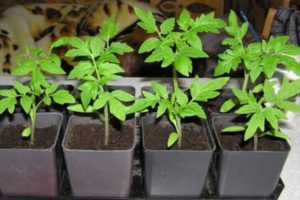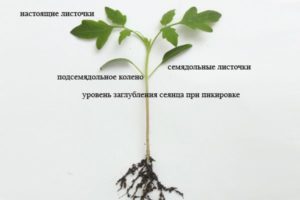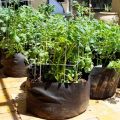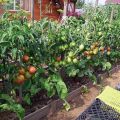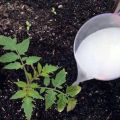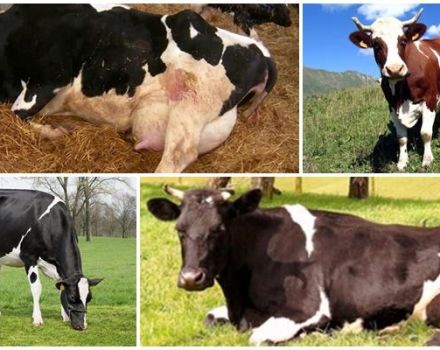Step-by-step instructions for growing bags of tomatoes
Tomatoes in bags can be grown both outdoors and in a greenhouse. The bags in which the seedlings are planted are selected from polyethylene, large. They are filled with nutritious potting soil, which you can buy at specialty stores or make yourself at home. Growing tomatoes in bags requires a certain approach - it is not as easy as it seems at first glance.
The principle of planting tomatoes
Not all gardeners know how to grow bags of tomatoes. Tomatoes grow and bear fruit better than other vegetables in different containers. It is very convenient to move tomatoes from one place to another without damaging the root system or shoots, but peppers or cucumbers easily break when moving.
Initially, seedlings can be planted in small bags, with a volume of 25 - 30 liters. Each should be filled with compost - 20 kg in one container. Growing tomatoes in bags has an advantage: usually tomato seedlings are not planted in open ground until the end of the spring frost, and so the tomatoes can simply be transferred to the warmth in May, and after the end of the cold weather they can be put back on the site.
When transferring the bags from place to place, there is some risk that they can break at the bottom, where a drainage hole is made, which is necessary so that excess moisture comes out, and the root system of vegetable plants does not begin to rot.
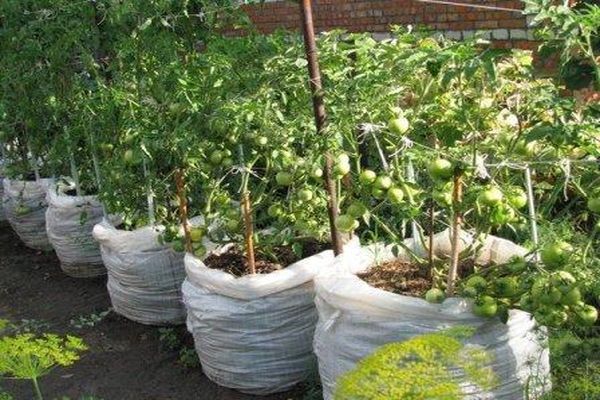
An important nuance is the choice of color. Dark attracts sunlight, the soil will heat up, which will adversely affect the root system and the condition of the tomatoes in general. In this case, inflorescences will not form well in tomatoes, and you will need to water more often.
Experts recommend using white sugar bags - they are more durable than ordinary polyethylene bags. Another advantage of such a container is the presence of natural holes for moisture to escape.
Planting and caring for tomatoes
When growing small tomatoes, the bags are filled with nutrient soil mixture by 1/3, for tall varieties it should be filled by ½. Then the tomatoes in bags are carefully placed in the greenhouse, tightly to each other, the top of the bag should be turned out.
Planting seedlings is carried out step by step as follows:
- Ready (or prepared independently) nutritional mixture is poured into a bag.
- Seedlings are carefully transplanted from the container to a permanent place - 2 - 3 plants can be planted in each bag, depending on their height.
- From above, the root system is covered with soil, the neck should be at ground level. The soil is carefully tamped.
- Planted seedlings are watered.
- Move the containers to the greenhouse. If the frosts have passed, they can be taken out to the garden.

Further cultivation of tomatoes is no different from the usual cultivation of vegetables. Watering is carried out every 3 - 4 days, more often in the heat. High-grade garters should be done at the base. Top dressing is carried out several times a season - before flowering, during fruit setting and during the ripening of tomatoes.
After the entire crop has been harvested, the tops of the tomatoes are pulled out and burned. The soil should be poured into the compost heap. Do not throw away the bags: they will perfectly serve for growing tomatoes for at least 2 - 3 seasons.
Advantages of the method
The undoubted advantages of tomatoes grown in this way include:

- "Beds" with tomatoes can be placed where it is convenient for the vegetable grower;
- if cold days come, the plants can be removed to a warm room;
- moisture evaporates more slowly, so you can water this "garden" less often;
- a small amount of soil in such containers warms up faster and cools down more slowly.
As a result, growing tomatoes in bags is even easier than using traditional methods.
What materials will be needed for the experiment
Growing tomatoes in bags is not much different from the standard, you just need to prepare for planting seedlings. Required:
- Bags. It is better to use large bags for planting, in which there was previously sugar (30 or 50 kg): they are durable and better allow moisture and air to pass through than similar plastic bags. Drainage holes in such a container are made simply - just cut the corners.
- Priming. The prepared soil should have a neutral reaction - it will develop worse in acidic or alkaline tomatoes. For better looseness, sawdust or vermiculite is added to the soil. The bag can be filled with rotted manure or humus by 0.5 volume, and the rest of the space - with ordinary soil: until the ovaries appear, the tomatoes can not be fed. Some growers only use compost as filler.
- Supports for tying tomatoes. Usually they use slats, ropes, wire - they are pulled at a low height above the "vegetable garden", and the shoots are tied up with ordinary twine. Wooden stakes can be inserted.
Having prepared everything necessary for this method of growing tomatoes, you should pay attention to the seedlings - how suitable the seedlings are for planting in new conditions (this method differs little from the greenhouse method). Healthy, robust seedlings must meet the following requirements:
- height - about 28 cm;
- the color of the stems and foliage is richly emerald;
- flowering seedlings should not be;
- seedlings should be planted at the age of about 60 days and with 7 - 8 permanent leaves.
Only seedlings that meet the above requirements will grow well and give a bountiful harvest.
The nuances of growing
If it suddenly gets colder, you can not drag the container into the warmth, but simply close the sprouts with the free edges of the bag. If the temperature drops too much, the plants should be briefly removed to a warm place.
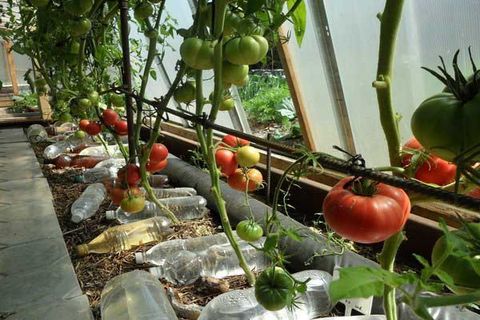
Watering should be regular, but not plentiful, as moisture slowly leaves, and its stagnation can provoke rotting of the root system.
In the first month after planting the seedlings, it may be necessary to add soil to cover the growing new roots.
When the bags are reused, they are pretreated with Bordeaux liquid or potassium permanganate to prevent the development of diseases in tomatoes.
Growing tomatoes in bags is already a fairly popular method that many summer residents have adopted. Especially this experiment was "to the taste" of gardeners with small plots of land.
